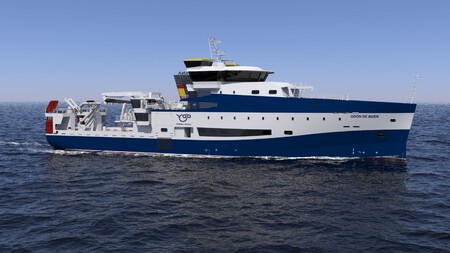When, at the end of the 19th century, he embarked on the white frigatean ancient Navy ship, with a wooden hull and propelled by a steam engine and its own sails, the naturalist from Zaragoza Odo of Buen and Cos maybe I sensed a couple of things. That the nautical expedition through the waters of Europe and North Africa promised to be fascinating. Which would be tough. And that it could have a decisive influence on his scientific career, inclining him, as in the end, towards the study of the oceans. What Odón de Buen could hardly imagine is that decades later, well into the 21st century, his name would name a brand new oceanographic vessel.
And not just any ship. The Odón de Buen will be one of the most important ships of the national investigation, “the flagship of the Spanish scientific fleet”, in words of the Spanish Institute of Oceanography (IEO-CSIC).
Its dimensions and equipment will allow it to surpass even the oceanographic research vessel (BIO) Hesperidesthe legendary ship built in the early 1990s in Cartagena and used both for research and to serve the Antarctic bases, such as the Juan Carlos I.
peek into the depths
At the moment the ship is just a project. One, yes, that goes taking shape in the facilities of the armon shipyard, in Vigo, and has just achieved a key milestone. Just a few days ago, its 84 m hull was thrown away so that the technicians can continue advancing in its construction. If all goes according to plan, the new ship will be ready. in 2024date confirmed this week by the CSIC.
Until then we can already enjoy the first images of the helmet, the infographics that show how it will be once finished and its technical sheet.
The Odon of Good will measure 84.3 meters in length by 17.8 beam, it will have capacity for 58 passengers, an autonomy of 50 days of navigation and will be able to travel between 200 and 300 nautical miles. The world precise which will have a displacement of almost 4,200 tons and will have diesel-electric propulsion, a generating plant that will supply all its systems and two LNG tanks.
“It will be able to operate in all oceans, including the polar regions, and will have the capacity to host 58 passengers, of which 39 will be scientists and the rest crew members. In addition, he is endowed with state-of-the-art technology, ” the CSIC abounds.
They are not the only details that have emerged from his file.

Launching of the ship, this week, in Vigo.

Frontal view of the ship, still in the shipyard.
The Odón de Buen has a clear oceanographic vocation. And as such, those responsible have designed it with a robust scientific muscle. “Its equipment stands out for being at the technological forefront through echo sounders, both for the study of the seabed and that of fisheries; unmanned, remotely operated or autonomous vehicles; sampling systems, dredgers and 500 square meters from laboratory”, they commented a year ago from CSIC.
Added to this potential is its enormous storage capacity for the transport of containers on deck, a valuable feature during logistics support missions to Antarctic bases. Thinking of his research, the ship has also been designed to be especially quiet, “a fundamental aspect”, explains the CISCboth when making observations of the ocean without altering its organisms and when working with scientific echo sounders.
One of its most surprising peculiarities is that it will allow scientists to peer into the seabed, to 6,000m deep. For reference, the remains of the Titanic rest at a considerably lower distance: at 3,800 m, at the bottom of the Atlantic. “She will be the most advanced of the Spanish fleet, allowing the study of ecosystems, habitats and seabeds in all oceans and at depths greater than 6,000 meters”, claim from the CSIC.
To dive into those abyssal depths, the Odon will include an autonomous underwater vehicle. The model, accurate The worldIt will be a Konhsberg HUGIN 6000 6.5 m long equipped with sonars, camera and profiling laser.
“The Odón will make it possible to study the ecosystems, habitats and seabeds in all the world’s oceans, including the polar zones, and at depths greater than 6,000 meters”, stood out CSIC last year. To give it shape, the project has an investment of about 85 million of euros, a large part contributed from Brussels through the European Regional Development FundFEDER.
A true titan of oceanography.
with the name of one of his great references.
In Xataka: Spain finally has its new star submarine: the Isaac Peral, 81 meters long and with the latest technology















